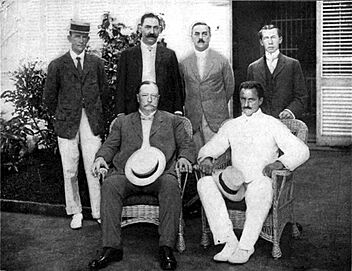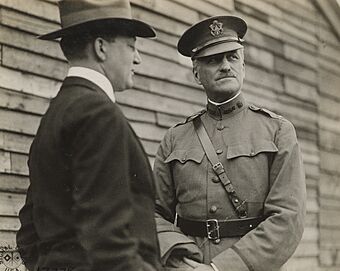Robert Bacon facts for kids
Quick facts for kids
Robert Bacon
|
|
|---|---|
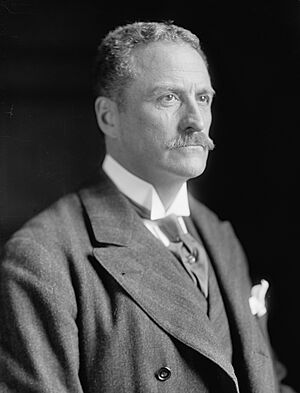 |
|
| United States Ambassador to France | |
| In office December 31, 1909 – April 19, 1912 |
|
| President | William Howard Taft |
| Preceded by | Henry White |
| Succeeded by | Myron T. Herrick |
| 39th United States Secretary of State | |
| In office January 27, 1909 – March 5, 1909 |
|
| President | Theodore Roosevelt William Howard Taft |
| Preceded by | Elihu Root |
| Succeeded by | Philander C. Knox |
| 26th United States Assistant Secretary of State | |
| In office October 11, 1905 – January 27, 1909 |
|
| President | Theodore Roosevelt |
| Preceded by | Francis B. Loomis |
| Succeeded by | John Callan O'Laughlin |
| Personal details | |
| Born | July 5, 1860 Jamaica Plain, Massachusetts, U.S. (now part of Boston) |
| Died | May 29, 1919 (aged 58) New York City, U.S. |
| Political party | Republican |
| Spouse | Martha Waldron Cowdin |
| Children | 4, including Robert, Gaspar |
| Education | Harvard University (BA) |
| Signature | |
| Military service | |
| Allegiance | |
| Branch/service | |
| Rank | Lieutenant colonel |
Robert Bacon (July 5, 1860 – May 29, 1919) was an American diplomat and politician. He served as the 39th United States Secretary of State for a short time in 1909. This was under President Theodore Roosevelt. Before that, he was the Assistant Secretary of State. Later, he became the Ambassador to France.
Bacon was born in Boston, Massachusetts. He went to Harvard College. At Harvard, he was a great athlete. He was captain of the football team and rowed crew. He also won boxing and track events. He became good friends with Theodore Roosevelt, who later became president.
After college, Bacon worked as a banker. He joined the famous firm of J.P. Morgan & Co.. As Secretary of State, he helped President Roosevelt with important treaties. These treaties were about the Panama Canal. He also worked to improve relations with countries in Latin America.
During World War I, Bacon strongly supported the U.S. joining the war. He helped create training programs for soldiers. In 1917, he joined the United States Army. He served in France under General John J. Pershing. He was a key link between American and British military leaders. Bacon died in New York City shortly after the war ended.
Contents
Early Life and Education
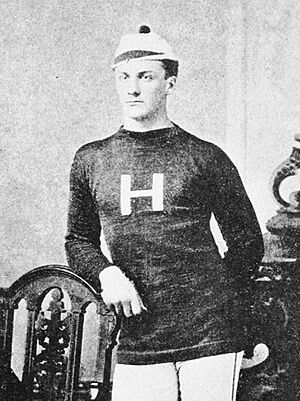
Robert Bacon was born on July 5, 1860. His hometown was Jamaica Plain, Massachusetts. He grew up in the Beacon Hill area of Boston. His father, William Benjamin Bacon, was a merchant.
Robert went to the Hopkinson School in Boston. In 1876, he started at Harvard College. He was only 16 years old. At Harvard, he was a very popular student and a star athlete. He was the captain of the football team. He also played on the freshman baseball team. He won a heavyweight boxing championship. He was also fast, winning races like the quarter-mile and hundred-yard dash.
He was president of the glee club. He was also a leader for his graduating class. He became close friends with Theodore Roosevelt. Roosevelt later became a U.S. President. They were sparring partners at Harvard. After graduating, Bacon traveled the world. He visited places like Japan, China, India, and the Mediterranean.
Business Career (1881–1905)
Starting in Banking
Bacon began his career at an investment bank. It was called Lee, Higginson & Co. in Boston. The head of the firm, Henry Lee Higginson, was a family friend. In 1883, Bacon moved to E. Rollins Morse. There, he handled business for J. P. Morgan.
Working with J.P. Morgan
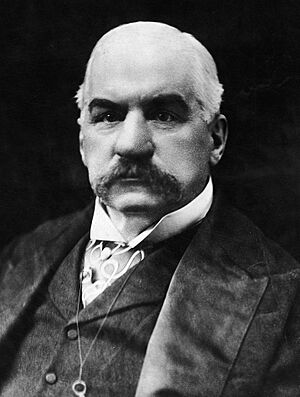
In 1894, Robert Bacon became a partner at J.P. Morgan & Co. in New York City. He stayed with the company until 1903. As a junior partner, he was one of J. P. Morgan's most trusted helpers. He often managed the American business when Morgan was in Europe.
Helping the U.S. Government
Bacon worked hard during his early time at J.P. Morgan. The firm was helping the U.S. government. The government needed to fix its finances after a difficult time in 1893.
In 1895, Bacon and J. P. Morgan met with President Grover Cleveland. The U.S. Treasury was running out of gold. Morgan suggested selling government bonds to private groups. This would bring in more gold. President Cleveland agreed to this plan. This deal helped prevent a financial crisis. Bacon's role in this deal earned him Morgan's trust.
Forming U.S. Steel
In 1898, Bacon worked on a big project. It was for the Federal Steel Corporation. This company wanted to buy other steel companies. They were especially interested in Andrew Carnegie's company.
Negotiations began in 1898. In 1901, the deal was done for $487 million. This was a huge amount of money then. This led to the creation of the United States Steel Corporation. It was worth over $1.38 billion. It controlled two-thirds of the American steel industry.
Railroads and Legal Challenges
In 1901, Bacon helped combine several large railroad companies. These included Morgan's Northern Pacific Railway and James J. Hill's Great Northern Railway. They also bought the Chicago, Burlington and Quincy Railroad. Another railroad owner, E. H. Harriman, tried to take over Morgan's Northern Pacific Railway. Bacon led the effort to stop this takeover.
This struggle caused railroad stock prices to rise very high. It almost caused a financial panic in New York. To fix this, a new company was formed. It was called the Northern Securities Company. This company would own stock in the three railroads. This helped calm the markets.
However, the U.S. government sued the Northern Securities Company. They said it broke antitrust laws. Bacon was named in the lawsuit. The Supreme Court of the United States ruled against the company. The Northern Securities Company was broken up. This case was very stressful for Bacon. He took a break from J. P. Morgan in 1903.
Diplomatic Career (1905–1912)
Assistant Secretary of State
On September 5, 1905, President Theodore Roosevelt appointed Bacon. He became the United States Assistant Secretary of State. Roosevelt was Bacon's old friend from Harvard. The new Secretary of State, Elihu Root, had asked for Bacon.
As Assistant Secretary, Bacon worked on relations with Canada and Latin America. He helped advance Roosevelt's policy for cooperation in the Americas. He helped settle a fishing dispute with Canada. From July to September 1906, Bacon was acting Secretary of State. This was while Root was away. During this time, he advised Roosevelt on conflicts in Central America. He also helped settle debts for the Dominican Republic. He helped return land in Puerto Rico to the Catholic Church.
Helping Cuba
A big issue during Bacon's time was a rebellion in Cuba. Cuba was an independent country, but it was struggling. President Tomás Estrada Palma asked the U.S. for help. Bacon and Secretary of War William Howard Taft went to Cuba. They tried to make peace with the rebels.
No peace was reached. So, Taft announced that the U.S. would set up a temporary government in Cuba. Taft became the temporary governor. Bacon and Taft stayed in Cuba until October 15. Then, Charles Edward Magoon took over.
Secretary of State (1909)
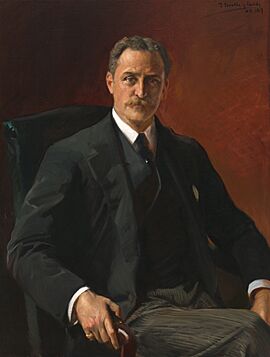
In January 1909, Elihu Root was elected to the U.S. Senate. Bacon was chosen to replace him as Secretary of State. He took office on January 27, 1909. This was just over a month before Roosevelt's term ended.
Bacon worked to get treaties approved by the Senate. These treaties were with Colombia and Panama. They were about the Panama Canal. The Panama treaty was approved on March 3. This was the day before Roosevelt left office.
Bacon also helped with the London Naval Conference. This meeting discussed rules for naval warfare. He also attended a conference on conserving natural resources. This meeting included Canada and Mexico.
Ambassador to France (1909–1912)
Bacon served as the United States Ambassador to France. This was under President William Howard Taft. He was ambassador from 1909 to 1912. His time as ambassador was not very dramatic.
When he arrived, Bacon helped with aid for the Great Flood of Paris. In 1910, he hosted Theodore Roosevelt in Paris. Roosevelt gave his famous Citizenship in a Republic speech there. Bacon also hosted annual celebrations for Latin American countries. He highlighted the similarities between their heroes and George Washington.
Bacon resigned as Ambassador in 1912. He was elected a Fellow of Harvard University. He and his family stayed in Paris to help the new ambassador. This caused them to cancel their trip on the RMS Titanic.
World War I Service
In August 1914, World War I began in Europe. Bacon went to France to help. He worked with the American Field Service. This group provided ambulances for French and British forces. He also helped set up a hospital near Ypres. His book For Better Relations with Our Latin American Neighbors was published in 1915.
Bacon strongly believed the U.S. should join World War I. He pushed for more military training. He was president of the National Security League in 1916. He criticized President Woodrow Wilson for not acting sooner. He tried to become a U.S. Senator for New York. He lost the election but promised to support the winner.
In May 1917, Bacon joined the United States Army. This was one month after the U.S. entered the war. He went to France with General John J. Pershing. Pershing commanded the American forces. Bacon was promoted to lieutenant colonel in 1918. He became the chief American military contact. He worked with British Field Marshal Sir Douglas Haig. Bacon returned to the U.S. in April 1919. This was five months after the war ended.
Family and Legacy
Robert Bacon married Martha Waldron Cowdin on October 10, 1883. They had four children:
- Robert Low Bacon, who became a U.S. Representative.
- Gaspar Griswold Bacon, who became Lieutenant Governor of Massachusetts.
- Elliot Cowdin Bacon.
- Martha Beatrix Bacon.
Bacon died on May 29, 1919, in New York City. He died from blood poisoning after surgery.
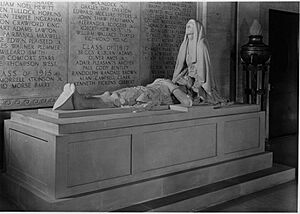
A sculpture called The Sacrifice was made in his memory. It was also for Harvard University alumni who died in World War I. The artist was Malvina Hoffman. The sculpture shows the head of a crusader on a woman's lap. It was first placed in a cathedral in New York in 1923. Later, it was moved to the War Memorial Chapel at Harvard in 1932.


